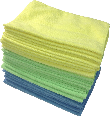The truth about whites is that "whites" is a very general term. Your whites may range from delicate silks to cotton sheets and towels. The one thing that holds them in a common connection is your desire for them to be brilliantly white. Delicates are so, well, delicate that they've earned a category of their own. For tips on how to wash them, refer to the tip entitled, "Washing Delicates." For everything else, these following tips will be useful.
The beginning or the end of your white laundry problems may reside in your choice of a washer. If you happen to be scoping out a new washing machine, be sure to get one with a second rinse cycle. That second run through the water will do wonders for your whites. If you are using a single rinse washer, consider turning the dial back on your white load and letting it rinse again.
In general your water temperature for whites should be warm or hot. The more heavy duty the material, the hotter the water should be.
The two struggles associated with whites are (1) maintaining whites, and (2) restoring whites. If you are working to maintain your clothes' whiteness, try any of these solutions:
If your white clothing is already getting grey and dingy with use, try one of these solutions to restore whiteness:
If you do not have any bleach, try this substitute procedure:
Soak your whites in large sink with 2 tablespoons of liquid dish soap (dawn or joy). Soak 15 min, rinse and drain. Soak whites again with 2 tablespoons of ammonia, soak 15 min, rinse and drain. Soak with 2 tablespoons of white vinegar, soak 15 min, rinse and drain. Wash as usual in washer then line dry if you can; the sun has whitening effects. When rinsing, be sure that your rinse is thorough. This should be used on a one-time basis. Regularly washing your clothes this way will shorten their life.

The Power of Microfiber! Zwipes Microfiber Cleaning Cloths will become your favorite tool for every cleaning task. This 36-cloth package is perfect for hundreds of uses in the garage, kitchen, bathroom, laundry, and all around the house. Each cloth is tough, streak-free, lint-free, reusable, and washable. Check out Microfiber Cleaning Cloths today!
Not all sheets can be cleaned the same way. There are some sheets that are just a little bit more delicate, and require ...
Discover MoreWhile it can be annoying to find that your white apparel and linens have turned yellow in the laundry, it no longer needs ...
Discover MoreIt happens to all of us. One sneaky red sock gets into the light colors, and before you know it, your whole laundry load ...
Discover MoreFREE SERVICE: Get tips like this every week in Cleaning Tips from Tips.Net. Enter your address and click "Subscribe."
There are currently no comments for this tip. (Be the first to leave your comment—just use the simple form above!)
FREE SERVICE: Get tips like this every week in Cleaning Tips from Tips.Net. Enter your address and click "Subscribe."
Copyright © 2025 Sharon Parq Associates, Inc.
Comments